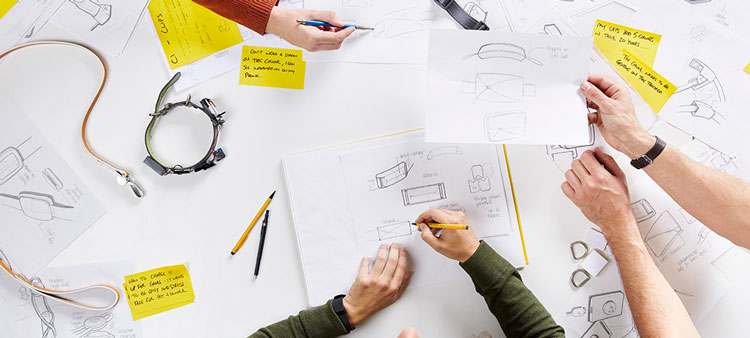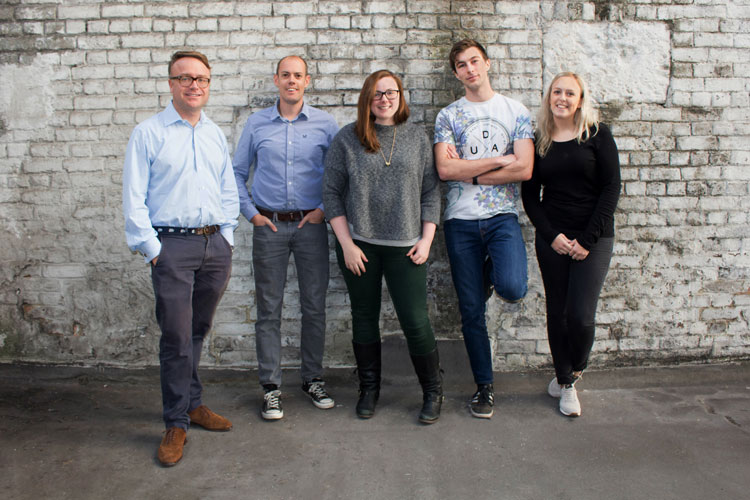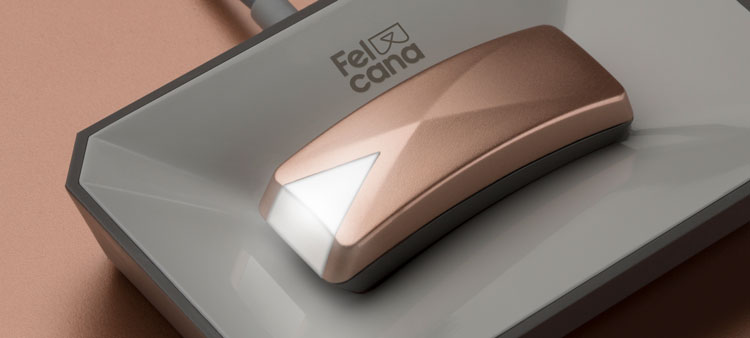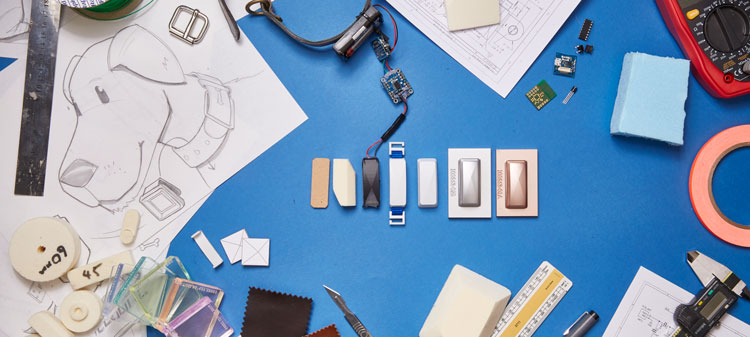Felcana is the new generation of digital pet care. It is an ecosystem of connected and responsive smart devices to monitor your pet. Designed by experienced vets and developed by inventive engineers.
One of those vets, and one of the co-founders of Felcana, Dr. James Andrews, told eeDesignIt: “I’m a vet with commercial strategy experience as well. So there was quite an interesting overlap between veterinary medicine and business. We saw a huge gap in the market when it comes to pet technology. We founded two years ago and we’ve now gone from two co-founders to over ten members – it’s all very exciting.”
Co-founders James Andrews and Kimberley Schiller, both vets, hatched the idea for Felcana in a restaurant one evening, in a discussion about the interesting applications for pet technology.
They started looking at wearable devices and how they could gather information that is clinically relevant and helpful to pet owners and vets.
For example, Felcana gathers information on all of the fundamental things that indicate disease in cats and dogs: lethargy, inappetence, change in appetite, drinking frequency and temperature. Something as simple as a dog drinking more water than normal can be a sign of polydipsia which is caused by diabetes – and is not something that a pet owner might necessarily notice.
The Felcana app processes this information in real time and provides a breakdown of the data and a historical trend. In the future, the startup plans to offer a bespoke veterinary dashboard with a granular analysis for vets.

Since then that idea has grown quite a lot. “Now we think of ourselves as a pet data company, we undertake pet data acquisition through connected devices or other opportunities for acquisition. We are a pet data storage company and we are a pet data analytics company because we really analyze the data we get to gain insight,” explained Andrews.
“We had seen some of the connected devices that existed in the ‘human’ world and thought ‘well why don’t we have something similar for pets?’ We did some research on the devices that were out there two years ago, and they didn’t have a clinical focus, it was more fun for your pet.”
The first step for Felcana was market research, they established that the market opposition was opportunistic for their startup and that there was market demand through research with pet owners. They then undertook an exercise to understand how to build the business through fundraising.
“What you find out is that fundraising is not trivial. Raising £5m off the bat was not going to happen. We went down the route of applying for government grants – there is a lot of money for innovation supported by the Government. We went through Innovate UK and applied for a small proof of concept grant and were lucky enough to be successful in the very first round. This allowed us to raise capital in the private investor market because we had the government grant already in our business,” said Andrews.

Top tips for a tech startup with an idea:
- Hire the best people possible.
- Don’t spend too much money.
- Grow your network, talk to the best people within your field.
- Listen to your market research, if it doesn’t agree with your idea be flexible.
- It’s going to be a lot harder than you think.
- Fundraising is going to take longer than you think.
- Don’t try to be cool – you get a lot of startups who want a trendy office and pay a fortune for it to hang around with people who wear trendy glasses all day. You want to be building a business, and be in the right place for this.
The team currently has a split of 25% vets, 50% engineers and 25% ‘other’ (marketing, graphic design, UX experts, bookkeeping), but there is some overlap.
“Our vet team all have non-first line clinical experience. We have vets who have worked in clinical practice but also in commerce environments – we had a team of vets that wanted to build a product. I think it works pretty well,” said Andrews.
The biggest surprise in your startup journey so far?
“Our competitors,” Andrews said, “How many of them are either launching products or are making claims that are not credible. It would be very easy as a pet owner to see a product that you think ticks all the boxes when actually when you purchase it (if it gets delivered) it would be a very underwhelming experience. It’s a challenge in the industry, weeding out these products that are totally useless. Unlike us building Felcana that is built on science and credibility.”
Grace Nolan, Social Media and Communications Executive answered: “The response from the public. I thought it would be a lot harder to convince the public at times that there was value in the product we were offering – to help them understand how the electronics can complement all the other things they do to keep their pet healthy. There was a little resistance, but when we went into detail you could see the light come on in their head, and then they would get so involved in the company and with the product development. So having that community come together was surprising and exciting.”

The crowdfunding journey
Felcana fundraised on Kickstarter in November 2016 and raised £26,191 with 250 backers.
“Kickstarter was an interesting experience. We did it to test our product on the market. It was great and the feedback helped with our product development and business branding – it also got us quite a lot of exposure,” said Andrews.
“It also enabled us to get an early cohort of pet owners to find out what was really making them tick with the product,” said Nolan.
Andrews offers his advice with regards to crowdfunding:
“Our hypothesis going into Kickstarter is that most people backing us would be in the UK and US, but what we found is that there any many other countries that we had backers coming from that we wouldn’t have forecast.”
“You can split crowdfunding into pre-sell (Kickstarter, Indiegogo) and equity funding. We have not done the latter. But with regards to pre-order funding I think it is a really good thing for any B2C product to do. I would highly advise anyone to do this purely to finance your business. It really is a platform purely for building a community of early adopters that you can use to test your products, have as advocates to talk about your product – and you can learn from them.
The Kickstarter campaign design:
“The other learning curve was that it is really time-consuming, especially if you want something credible. Anyone can knock together a Kickstarter campaign in a day, but to do a good campaign requires a lot of up front investment; copy, photography, video. It’s not a trivial exercise. Go into it with the right mindset. Use it as an exercise to learn more about your customers and the product you are building.
“I would advise against paying too many people to help you, it’s all about the market research and if you’re just paying someone to do it for you, you will not learn anything yourself. Even if this means having a lower threshold of success on Kickstarter. My guidance with regards to setting a goal is keep it as low as you can.
“Then there is equity crowdfunding which we haven’t done. I don’t like it very much as it is a very public way of raising finance, and more often that not particularly with finance, being public isn’t in the interests of the company. For example, on CrowdCube you normally have to publish your financial forecast in terms of marketing spend, etc, which we’d rather keep quiet than tell our competitors how much we are going to spend or how much we have raised. We don’t want them to know our fire power.”

Resources
- Pitch@Palace, an initiative run by Prince Andrew, is a very credible setup that is great for networking.
- SolidWorks provided us with support with regards to suppliers.
- What not to use: “Avoid every accelerator that exists unless you have a serious capability gap around commercial expertise, because they take such a huge portion of your business and often don’t have any great capabilities themselves. It is better to recruit in-house,” advised Andrews.
- Go to as many exhibitions and startup shows as you can – like Hardware Pioneers – they are a not a huge time commitment but they can help you to build your brand and it’s a great opportunity for networking.
- Speak to your customers as much as possible as a resource. At Crufts for example, there were 100,000 dog owners who provided us with great feedback.
The human and pet User Experience (UX)
“We spent a lot of time talking to pet owners and vets, and built prototypes to let people play with them and get a feel for it in their home. We went to people’s homes for hours and interviewed them very early on,” said Andrews.
Nolan added, “Later on we did another round of testing. We went to people’s houses with mockups of different versions of what the app could look like – but on paper. We played around with what features they would like to see on the app and the home screen, and found out what different colors resonated with them. It was about creating that meaning between the owner and the data they were being fed back.”
“Also we tried the different iterations of the product on their pets, to see whether the pet was bothered by them,” said Andrews.
“Going to Crufts in 2017 also gave the team a real morale boost, to see the demand from the people we will eventually be selling to. We then integrated all of their feedback into our product,” said Nolan.
Even the startup’s name ‘Felcana’, a play on feline and canine, was born out of a competition and thought of by pet owners. The name was important as it allowed Felcana to build a brand that wasn’t just focused on a single product.
Design priorities
- “Miniaturization,” said Andrews, “Especially for any of our products that are worn by an animal. Again many of our competitors’ products weight 60-70g, which when placed on a four kilogram animal can be substantial. It’s the equivalent of carrying a can of Coke around your neck – something that pet owners might not necessarily realize. Ours weighs 8.3g.”

- Tight hardware and software security in place to protect data.
How did you find working with animals to produce a product?
“Most people in the team have pets – our electronic engineer grew up on a pig farm!” Andrews told eeDesignIt, who himself has a dog and a cat. In terms of working with the animals to produce the product, Andrews said that they, “didn’t add too much chaos.”
The future
In the future Felcana has plans to partner with human fitness tracker products, depending on demand, to allow users to compare and collate their activity data with their pets.
Felcana have a detailed product road map which includes new hardware and software, and other products not yet talked about. “Watch this space,” Andrews said. There are plans for at least two new products in 2018.
The Felcana technology is relatively transferable to other species, though one of limitations is that whilst the technology is the smallest available on the market, it is still not small enough to be used by hamsters, for example. In terms of larger animals like horses or cows it is pretty transferable.
Felcana currently has a range of half a mile, which with new communication technology solutions the team hope to improve, as well as including GPS tracking. Though because current GPS tracking technology can be unreliable and provide false positives, Felcana will wait until the technology is accurate.
Sum up your startup experience so far in one sentence:
Andrews: “Dynamic and busy.
Nolan: “Unpredictable but exciting and challenging.”
Product and team lifecycle dates
- May 2015: Felcana founded by a team of veterinarians.
- November 2015: Awarded Innovate UK grant funding.
- January 2016: Team recruitment and R&D underway.
- March 2016: First working prototype.
- November 2016: Launch on Kickstarter.
- January 2017: Final life and performance testing of completed design.
- April 2017: Tooling and pre-production.
- November 2017: First batch shipped.
